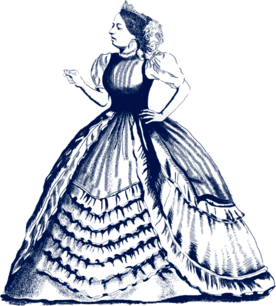Rightly or wrongly, the Mulready postal stationery of 1840 was widely ridiculed by the press and its professional rivals. Peter Chadwick shows how contemporary stationers leaped at the opportunity to mock the Mulready in this preview from the June 2024 issue of Gibbons Stamp Monthly
MULREADY CARICATURES:
A SATIRICAL SABOTAGE
By Professor Peter Chadwick
While the Penny Black would go down in history for its role in revolutionising communications and boosting literacy among the masses, the illustrated Mulready postal stationery letter sheets and envelopes that were introduced alongside it were widely mocked in the media and by the public. Some of the biggest naysayers of the Mulready were contemporary stationers who produced numerous pieces of stationery that ridiculed the Mulready design. Peter Chadwick showcases a few of the Mulready caricatures that were produced.
When penny post was no longer a pipedream, but something sure to happen, the Post Office had to determine how the postal charge was to be prepaid. A popular suggestion was by means of sticky bits of paper (we now call them stamps); but the Post Office believed these would be wanted only for a small proportion of the total mail, they believed prepaid stationery would be more popular. They commissioned a well-known artist, William Mulready, to design appropriate stationery, which he did. The resulting design, beautiful but pompous, is well known (Fig 1). The Mulready was issued on 6 May 1840, but examples could be purchased as early as 1 May.
The stationers, particularly in London and Edinburgh, believed (incorrectly) that by issuing this postal stationery the Post Office would undermine their business. Immediately they started to try to discredit the ‘Mulready’ stationery, first by arranging derogatory comments in the press, and then by producing and offering for sale caricatures lampooning the Mulready design. One article, in the Berkshire Chronicle of 16 May 1840, described them in these terms ‘..Mr Mulready’s cover, with its wilderness of Gorgons, and Hydras, and Chimeras dire’. This might well have been written for the newspaper by one of the stationers.
Mocking the Mulready
The most famous caricatures are those issued by Fores, by Southgate and by Spooner, all in London, although stationers in Edinburgh (e.g. Hume and Menzies) were also prominent in this way. One major stationer who believed his business was threatened, was Fores at the corner of Piccadilly and Sackville Street. His first ‘caricature’ was an outright mockery of the Mulready, which first appeared as a broadsheet in an issue of Punch, and was later reduced in size to make an envelope: Figure 2 shows this caricature, often referred to as ‘lion with sunglasses’.
Walter Scott, in Ingoldsby Legends, refers to the original Mulready design:
‘…A set of those odd-looking envelope things
Where Britannia (who seems to be crucified) flings
To her right and her left funny people with wings
Amongst elephants, quakers, and Catawba kings…’ 
These are exactly the subjects of the original lampoon. A monkey was riding on the lion with sunglasses, and an American and a Chinaman were both cocking snooks at Britannia. It was drawn by John Leech, another eminent artist; the broadsheet form appeared within ten days of the issue of the original Mulready, and the envelope was on sale by 20 May.
This proved so popular that Fores then commissioned a 16-year-old boy, Dick Doyle, to produce ten designs for them. The first designs were social commentaries, with the absurdities all slightly exaggerated: for example the Musical envelope (Fig 3) with a series of musical situations with which everybody would be familiar, but all somewhat overstated. This gradually evolved into envelopes which ridiculed the ‘establishment’.
The other very early broadsheet caricature quickly made into an envelope, was drawn by a regular Punch cartoonist, ‘Phiz’ (Fig 4); Britannia has been replaced by Mrs Jarley from Charles Dickens’ Old Curiosity Shop, the elephant has acquired spectacles and a top hat, the lion has been replaced by a terrier writing a letter to another dog, an African has received a letter and is celebrating with a quart of ale, and two lady baby-farmers are dispatching a baby by post. Sadly, this was Phiz’s only attempt at a caricature: I wish there had been more!
Another prominent publisher of caricatures was Spooner: my favourite is their envelope no.8, (Fig 5) lampooning the Queen’s first baby, with the Queen telling Prince Albert’s mother how Albert will be useful at rocking the cradle: Albert is practicing by rocking an empty cradle: and Lords Melbourne and Morpeth are playing the roles of wet nurses.
One of the cruellest caricatures – and within three months there were some very cruel ones – was the ‘Papal’ envelope from Southgate (Fig 6): with Britannia replaced by a Pope with a devil sitting on his shoulder: Irish nationalist leader Daniel O’Connell kissing one of his feet; the lion replaced by a donkey; and three Doctors of the (Catholic) Church assisting a Highlander to swallow a baby. Catholics were not popular in England at that time, and were then considered a good butt for jokes.
The colour of money
The intention was to sell these envelopes, which of course needed stamps, as a source of revenue for the stationers. In fact, most were bought as souvenirs, and not used for postage; sometimes they were given as small gifts – today, when you go to supper with someone, you might take a box of chocolates: in 1840, the latest caricature was an acceptable gift.
When the stationers realised that these caricature envelopes, which they normally sold for one penny, were being used as gifts, they had the idea of colouring them: and they employed girls in garrets, ‘homeworkers’, to do the colouring: they paid the girls a halfpenny, or less, per envelope coloured; and sold them for 2d. This is the origin of the jingle, ‘Penny plain, twopence coloured..’ The girls who did the work, just like Mimi in Giacomo Puccini’ opera La Boheme, were ruining their eyesight for a pittance, possibly 1½d. an hour or less, so they could just keep alive but could not afford decent lighting or healthcare.
Nowadays, an unused caricature envelope will probably cost from £150 upward; two to three times as much if coloured; five times as much, or more, if postally used. Most postally used have a penny black: some a red ‘1’ in manuscript: less have a penny red.
Prying eyes
The politicians of 1840 were not the fine, public-spirited honourable men we know today. The home secretary (Sir James Robert George Graham) arranged for letters to be opened secretly, so that he could read the contents and find out if any of the opposition were plotting against the government. When this became public knowledge, it caused an outroar, and Punch led the way in criticizing and cartooning. One Punch cartoon was reduced in size and turned into an envelope (Fig 7) which was widely used to publicise his dishonest treatment of the mail. In fact, the criticism was so effective that he lost his job and is now remembered only for these ‘Paul Pry’ activities.
The Deraedemaeker reproductions
A Belgian merchant, Deraedemaeke, recognised how popular these cartoons were, and how large the market for them was in Britain. He paid someone to make ‘perfect’ copies – and had them printed by a Belgian printer, Moens: and then sold them in Britain. This breached English copyright law, but it was hard (and expensive) to catch offenders and, anyway, British copyright law was not respected in Belgium! Deraedemaeker copies of some of the caricatures are readily available, typically for about £40-£50 for an unused one in good condition.
Illustrated propaganda envelopes
The great days of the caricatures were 1840-1843; the fashion for them passed after this – long after the Mulready stationery had been withdrawn – but they had started a fashion for illustrated envelopes: individuals started illustrating envelopes, but also promoters of ‘good causes’ used illustrated envelopes to advertise their causes. An example is Ocean Penny Post (Fig 8), others are Peace and Universal Brotherhood. This in turn led to the first commercial advertising envelopes – pictures of anything from looms to serviettes appeared on envelopes from industrial companies.
From 1890 to 1900, a prominent illustrator and cartoonist used the medium of illustrated envelopes to make his political points. Harry Furness both disliked and despised Gladstone, he is well known for a series of envelopes ridiculing the Prime Minister, of which the most famous is his comment on Irish Home Rule (Fig 9), which shows him beheading the Queen, implying that Irish Home Rule was similar to cutting the head off the monarchy. But my favourite, of many wonderful skits, is his depiction of the Boer War (Fig 10), pointing out that there were two losers – Britain and the Boers – and one winner – the United States, who took a lot of trade from Britain while we were fighting the war. I particularly like the vignette half way down the west side of the envelope: ‘False News. The Daily Liar, ½d’. Not a lot has changed!
Further reading
This article is based on an exhibit with which I won a gold medal in York five years ago. An excellent new book, published by the Royal Philatelic Society, has just appeared: The Mulready Caricature, by Cassell and Hobbs. It is not inexpensive, but it will be the standard reference book on these fascinating caricatures long after most of us have hung up our tweezers. Publication of this book motivated me to write about the caricatures in my collection.
Mulready Caricatures
Major E B Evans: The Mulready Caricatures. S R Publishers, 1970
Bodily, Jarvis and Hahn: British Pictorial Envelopes of the 19th century. Collectors Club of Chicago, 1984
Cassell and Hobbs: The Mulready Caricature. RPSL 2024
If you enjoyed reading this article consider a subscription to Gibbons Stamp Monthly, The UK’s best selling stamp magazine and the official publication of the world’s oldest and most famous name in philately - Stanley Gibbons.
Consistently over 150 pages each month, with up to date news, auction results and everything else from worldwide postal authorities and the hobby of philately. Learn more about our special offers on online and print editions at the link below.
Learn more about Gibbons Stamp Monthly
Shop Mulready Stock in our online store














